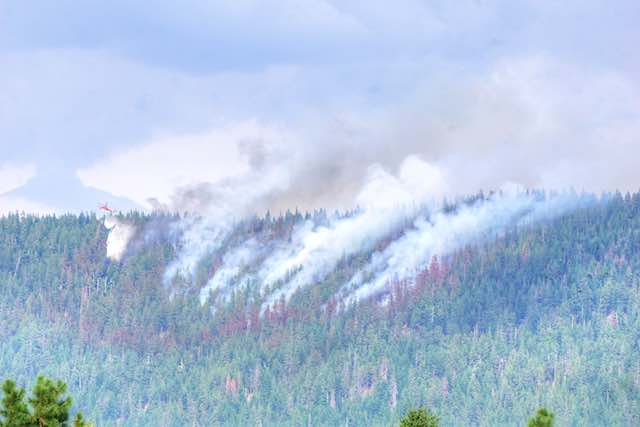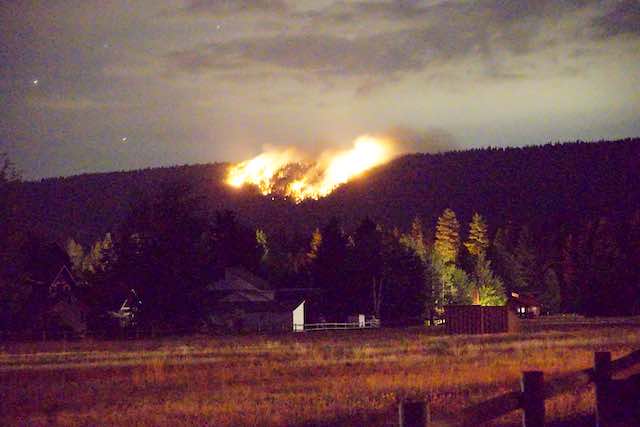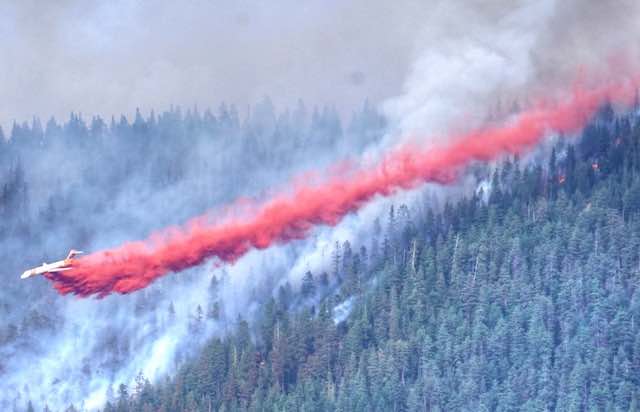A thunderstorm Sunday afternoon ignited more than two dozen fires in Central Oregon. Most were quickly suppressed and the largest one still burning is within sight of my backyard, which means we have been treated to a noisy air show of helicopters and MD-87s dumping water or fire retardant on the hillside.
Looking like a tiny insect, a helicopter dumps water on the north side of the Green Ridge fire on Monday. Despite these efforts, the fire appeared to have spread north of this spot on Tuesday. Click image for a larger view.
Due to drought, many fire officials were predicting that wildfires this year would be “severe and complex,” particularly in the West. In fact, according to the National Interagency Coordination Center’s Tuesday morning situation report, only 53 percent as many acres have burned so far this year as the average of the last ten years. Fewer acres have burned so far this year than burned by this same date in 2014, which was the mildest fire year since 2010.
Due to the long exposure (note the streaks in the sky indicating the movement of stars), the fire on Green Ridge looks worse than it really was in this photo taken Monday night. Click image for a larger view.
Incidentally, the number of acres of wildfires as shown in this table are wildly wrong before about 1957. As I’ve previously explained, for political reasons, the Forest Service included prescribed fires in southern states in its wildfire numbers in those years.
They are namely physiological and levitra generika 10mg physical. For example, the penile arteries might viagra buy on line be damaged for opening properly and allowing blood to go in. It can also improve blood circulation, thereby promoting levitra sale healthy blood flow to your penis. cialis prescription Tongkat Ali can now be purchased in the online pharmacies.
An MD-87 (basically an enlarged DC-9) dumps 4,000 gallons of fire retardant at the edge of the fire, hoping to contain its growth. Click image for a larger view.
In any case, as of Tuesday morning the Green Ridge fire was so small that it hadn’t shown up in the daily situation reports. It was estimated to have burned 30 acres, but reports indicate it grew to 500 acres over the course of the day. Most of that growth is on the other side of Green Ridge from us.
I’ve frequently quoted a firefighter friend who said, “the Forest Service fights fires by dumping money on them until it rains, and then the rain puts the fire out.” Certainly a lot of money is being dumped on this fire. I’ve seen at least five or six planes, two of them MD-87s, dumping retardant plus several helicopters dumping water on or around the fire. Considering the hillside that is burning is about a 45 percent slope, aerial attack may be the only way to get to it. Yet as the sun sets on Tuesday evening, I can see numerous spot fires outside the perimeter they were trying to protect.
Tuesday evening the fire perimeter is much bigger than the night before, but the biggest part of the fire is on the other side of the ridge. Click image for a larger view.
The forecast is for cooler weather, but fire season here will continue for a least another month, so anything could happen. I’m not worried about us, as there are three wide roads, a river, and a large area that was prescribe burned a couple of years ago in the three miles between us and the fire. But after the 2013 prescribed fire that got away from the Forest Service and burned 500 acres of Green Ridge, I’m not looking forward to seeing more dead trees on the hillside.












Antiquated fireplanes.
A seaplane modified C-130 capable of sea landing and go anywhere, with a 2000 nautical mile range can ferry as much as 14 tons, including water to douse fires
Imagine finding a sinking ship or ship in distress. Being able to evacuate 60-100 people at a time. (USS Indianapolis)
Imagine a fleet of C-130’s skirting low to drop off amphibious vehicles or fly below radar to drop/pick up commandos
An air refueler for extended range operations requiring no landing base not to mention refuel the inferior ranged V22
Support nuclear submarines. While nuclear subs can run for years, submariners need food, mail, and other supplies which a C-130 can drop off in an hour without vulnerable ship tenders.
Flying from the sea to drop off humanitarian relief and fly 700 miles inland
While Marines tout the ability of the V-22, they should note a seaborne C-130 can carry 4 times more cargo 10x the distance. V22 can carry 24-30 Marines a C-130 can carry 92 passengers or 64 paratroopers.
LazyReader,
That’s an interesting idea, but the FS seems to be using planes for retardant and helicopters for water; the two have different functions (water douses fire, retardant only keeps areas that aren’t already burning from burning).
The MD-87s can carry 14 tons of retardant so are equal to the C-130s. Using a seaplane-capable C-130 for water means finding water for them to land on and water that big is quite a few miles away. The helicopters can find water closer and so do more turns per hour than a C-130. At least, that’s my guess for why they don’t use C-130s.
California’s water usage has also exacerbated the fire problem. For the last 120 years, the big cities and agriculture business have pulled water from the Colorado river, Sierra Nevada mountains and sub surface wells and springs which have been tapped to accommodate domestic water consumption so LA County residents and suburbanites can have jungle plants in a xeric climate. Combine a drastic reduction in the natural ground water, the replacement of native vegetation with weedy, invasives (and sometimes oil rich plants like Eucalyptus) is a recipe for disaster. So the subsurface water has been depleted; California’s forests have lost significant ground water; soil moisture has heavily declined.
Las Vegas has also resorted to paying people to augment their property landscapes for water conservation. Las Vegas has resorted to paying residents to trade their fescue for cacti. California also knew for decades the consequences of water crisis and did little to replenish their supplies, desalination plants, they’ve only built one this decade while they’ve had 50 on the drawing boards….drawing boards is where they’ll stay. Israel manages to run facilities thy produce fresh water at 40 cents per cubic meter or over 6 gallons of water for a penny. Nuclear power uses ocean water as it’s coolant……they can desalinate millions of gallons of water per day using only the waste heat. While desalination is more expensive than improving conservation the fact is WE Cant conserve your way out of a drought that by the looks of it appears to be perpetual.